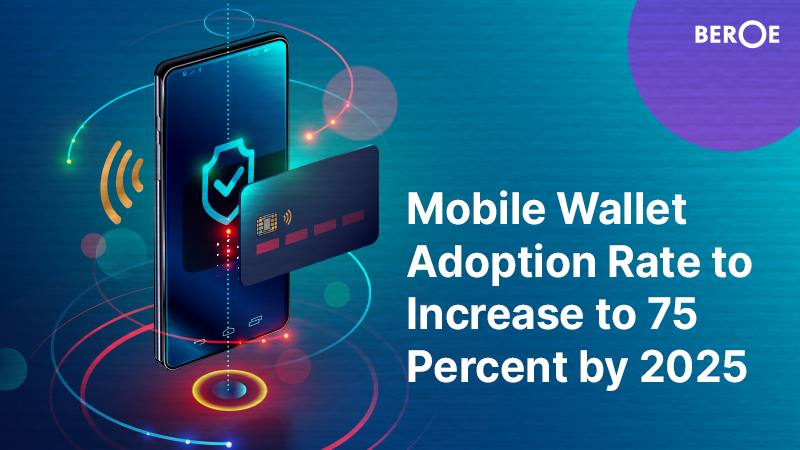Mobile Wallet Adoption Rate to Increase to 75 Percent by 2025, Says Beroe Inc
Source: PR Newswire

RALEIGH, North Carolina, Apr 23, 2021 - The global mobile wallet adoption rate is expected to witness an upward trend in the coming years amid an increase in the digital payment market through the usage of mobile payment wallets and contactless payments as an alternative to credit/debit card transactions on a global scale, says Beroe Inc.
The mobile wallet adoption rate in 2020, globally, was estimated to be 50-55 percent and is expected to increase to 75 percent by 2025. In the U.S. alone, current mobile wallet adoption levels stood at 22-25 percent.
Beroe, which is based in North Carolina, further stated that procurement experts can access this report on its recently launched market intelligence platform Beroe LiVE.Ai: https://www.beroeinc.com/beroe-live-ai/
The Asia-Pacific is expected to witness the highest estimated adoption rate of 38-40 percent in the forecast period, followed by North America at 25-28 percent. Europe and Latin America are both expected to see an estimated adoption rate of 10-12 percent, while Africa and the Middle East will see the lowest adoption rate at 8-10 percent.
The demand for digital payment is high since the beginning of the pandemic. The major multinational banks are reducing their cash transactions and looking to increase the adoption of digital payments and deposits. As for the supply outlook, the cheque processing supply is medium-high as the number of providers offering digital payments has increased since the start of the COVID-19 pandemic. The merchants are looking to increase their digital payment adoption.
With the pandemic raging on, various sectors such as entertainment and those associated with the tourism industry such as airlines and hotels have observed a global decline in global digital payments’ volume. As a direct consequence of the pandemic, business-to-business or customer-to-business-based payments across borders have also declined significantly owing to the temporary shutdown of borders. Global remittances have also been affected negatively.
On the other hand, with governments announcing lockdowns in a bid to contain the spread of COVID 19, clients are mostly transacting through digital banking, thereby increasing the usage of digital payments. The social distancing and other pandemic mitigation measures are likely to boost demand for digital banking services and this may also force traditional payments, like cheque processing, to be less adapted.
As of 2020, 15.85 percent of U.S. smartphone owners have used proximity mobile payment services and the most common mobile in-store mobile payment method was barcode or QR code scanning. Among these, a further 15 percent of customers had waved or tapped their mobile phone to pay at check out.
North American millennials (28 percent) and high-income households (42 percent) use contactless payments at least once a week, making them the largest adopters of digital payments. Furthermore, within the North American region, 55 percent of them are “extremely aware” of mobile payments, only 22 percent use them on a regular basis.
Key Findings:
- Almost 82 percent of banking executives are expecting to increase fintech partnerships in the coming 3-4 years.
- Fintech will offer banks a quick way to test and launch innovative services without completing their costly IT systems, while banks offer financial capital, an expanded customer base, and an imprimatur of greater legitimacy.
- Digital channels handling more multiples of transaction volume than as anticipated, latency could increase, potentially resulting in time out and lost sales.
- The sectors that have seen an increase in digital payments by way of increased adoption during the lockdown include online grocery stores, online pharmacies, OTT players (telecom and media), EdTech, recharges, and utility bill/payments.
- It has been observed that from the start of the COVID-19 pandemic, the demand for digital payments has increased globally.
- Due to the ongoing pandemic, the demand for digital payment has increased as most of the clients are transacting through digital banking for low as well as high-value transactions.
- It has been observed that globally the supply for digital payment has been stable and companies are looking to adapt to digital payments.
The report from Beroe includes:
- Digital payment market size overview
- Digital payment market trends
- Value chain analysis
- Market and industry analysis
- Supplier analysis
- Procurement best practices
- Cost and pricing analysis
About Beroe Inc
Beroe is the world's leading provider of procurement intelligence and supplier compliance solutions. We provide critical market information and analysis that enables companies to make smart sourcing decisions — leading to lower costs, greater profits, and reduced risk. Beroe has been providing these services for more than 15 years and currently works with more than 10,000 companies worldwide, including 400 of the Fortune 500 companies. For more information about Beroe Inc., please visit https://www.beroeinc.com/.
Media Contact:
Rob McMurtrie
rob.mcmurtrie@beroe-inc.com
Related News
View all
Beroe Makes Strategic Investment in Forestreet, Strengthening AI Capabilities and Driving Procurement Intelligence Innovation

Beroe introduces on-demand geopolitical risk analysis through PRISM enabling C-Suite to protect against ongoing supply chain disruptions
